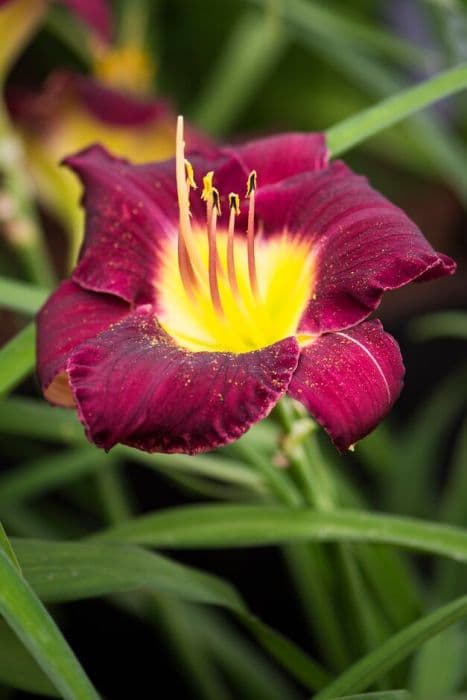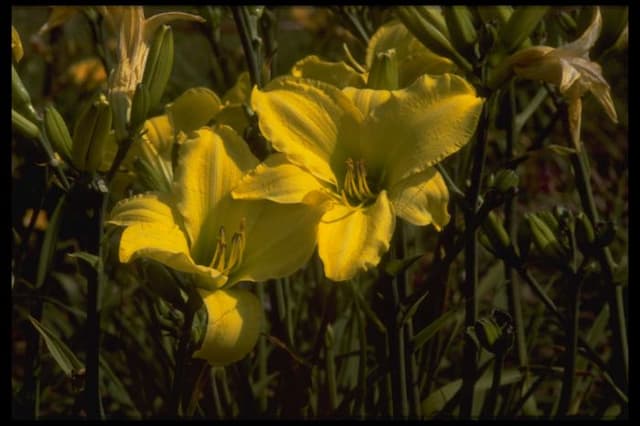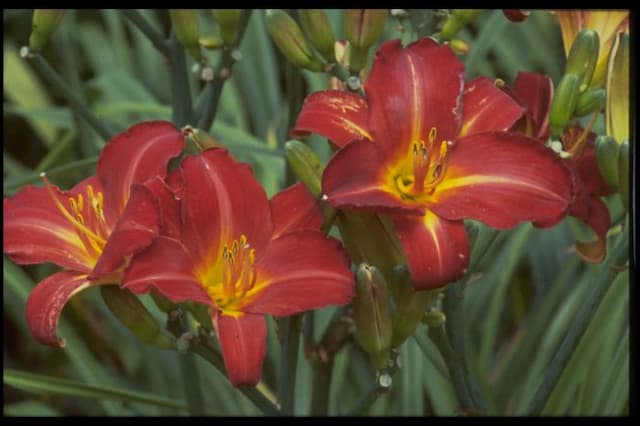Daylily Hemerocallis 'Little Grapette'

ABOUT
Hemerocallis 'Little Grapette', commonly known as the daylily, is a perennial plant known for its delightful and vibrant blooms. The 'Little Grapette' cultivar showcases a profusion of grape-purple flowers which possess a distinct, trumpet-like shape. Each bloom is graced with a striking contrast, featuring a lighter throat that typically presents in a pale, lemon-yellow hue. The individual flowers are borne atop sturdy, green stems that rise above the clump of foliage. The leaves are long, strap-like, and arch gracefully, forming a lush and verdant backdrop for the showy flowers. The foliage itself is a deep, glossy green, contributing to the plant's overall hearty appearance. Daylilies are known for their ephemeral blooms, with each flower typically lasting only a day before being replaced by another. Despite this brief life span, 'Little Grapette' can produce an abundant display over a period of weeks due to the presence of multiple buds on each stem. While the dimensions of 'Little Grapette' are not being specified, it should be known that the size of the blooms and foliage contribute to the plant's visual impact in a garden setting. This ornamental cultivar is appreciated for the color it brings to landscapes, with the purple of its flowers serving as a charming accent amid the greens of a garden or when used in masses for a stunning display.
About this plant
 Names
NamesFamily
Hemerocallidaceae
Synonyms
Daylily, Little Grapette Daylily
Common names
Hemerocallis 'Little Grapette'.
 Toxicity
ToxicityTo humans
The plant commonly known as Daylily is generally considered safe and non-toxic to humans. In fact, certain cultures eat the flowers of some Daylily species. However, it is always recommended to be cautious, as individual reactions can vary, and not all parts of the plant are considered edible.
To pets
The Daylily is toxic to pets, particularly cats. Ingestion can cause symptoms such as vomiting, lethargy, kidney failure, and in severe cases, could be fatal. If a pet ingests any part of a Daylily, immediate veterinary care is necessary.
 Characteristics
CharacteristicsLife cycle
Perennials
Foliage type
Deciduous
Color of leaves
Green
Flower color
Purple
Height
1 foot 6 inches (45.72 cm)
Spread
1 foot 6 inches (45.72 cm)
Plant type
Herb
Hardiness zones
3-9
Native area
Asia
Benefits
 General Benefits
General Benefits- Easy to Grow: Hemerocallis 'Little Grapette', commonly known as Daylily, is known for its ease of cultivation and low maintenance requirements.
- Drought Tolerant: Once established, daylilies have a remarkable ability to withstand drought, making them suitable for gardens in drier climates.
- Pest Resistant: The daylily is generally resistant to pests and diseases, reducing the need for chemical controls in the garden.
- Attracts Pollinators: With their colorful flowers, daylilies attract pollinators such as bees and butterflies, supporting local ecosystems.
- Extended Blooming Period: Daylilies have a long blooming season, with each bloom lasting just one day but with numerous buds on each stem ensuring a succession of flowers.
- Variety of Uses: They are versatile and can be used in borders, flower beds, and as ground cover or for erosion control.
- Adaptable: Daylilies can thrive in a wide range of soil types and environmental conditions, from full sun to partial shade.
- Propagate Easily: They can be easily propagated by division, enabling gardeners to expand their plantings or share with others.
- Colorful Foliage: Daylilies provide not only attractive flowers but also grass-like foliage that adds texture to garden designs.
- Non-Invasive: Unlike some perennials, daylilies typically do not spread aggressively, making them a good choice for controlled garden environments.
 Medical Properties
Medical PropertiesThis plant is not used for medical purposes.
 Air-purifying Qualities
Air-purifying QualitiesThis plant is not specifically known for air purifying qualities.
 Other Uses
Other Uses- As a natural dye: The flowers of the daylily can be used to produce a natural dye for fabrics or crafts, creating various shades depending on the mordant used.
- Culinary decoration: Petals from the daylily can be used to add a splash of color to salads or desserts, offering an edible garnish that's also appealing to the eye.
- Artistic inspiration: Artists may draw inspiration from the beautiful colors and forms of daylily flowers for painting, drawing, or photography.
- Garden design element: Daylilies can be used to create patterns and focal points within garden designs due to their diverse colors and sizes.
- Eco-friendly confetti: Dried petals of daylilies make for biodegradable confetti for outdoor celebrations, reducing environmental impact.
- Composting material: After blooming, daylily foliage and spent flowers can be added to compost bins as a green material that will break down and enrich the soil mix.
- Floral crafts: The flowers and leaves can be used in floral crafts such as wreath making or pressed flower arrangements.
- Natural pest deterrent: Some gardeners believe that daylilies planted around a vegetable garden may help deter certain pests, thanks to their robust nature and presence.
- Teaching tool: Daylilies can be used in educational settings to teach botany and horticulture, due to their ease of growth and maintenance.
- Water garden plant: Although not an aquatic plant, daylilies can be used in water garden design on the edges or in boggy areas, adding an attractive feature to such environments.
Interesting Facts
 Feng Shui
Feng ShuiThe Daylily is not used in Feng Shui practice.
 Zodiac Sign Compitability
Zodiac Sign CompitabilityThe Daylily is not used in astrology practice.
 Plant Symbolism
Plant Symbolism- Beauty: Daylilies, such as the Hemerocallis 'Little Grapette', often symbolize beauty because of their vibrant and attractive flowers.
- Transience: The daylily's individual blooms last for only a day, so they are often associated with the transient nature of life, reflecting the idea that beauty is fleeting.
- Motherhood: In Chinese culture, daylilies are a symbol of motherhood due to their nurturing growth and abundant reproduction.
- Renewal: As the 'Little Grapette' produces new flowers daily, it represents renewal and the endless cycle of life.
- Forgiveness: The daylily's ability to bloom anew each day can be seen as a symbol of forgiveness and a fresh start.
 Water
WaterDaylilies, such as the 'Little Grapette', prefer consistently moist soil, especially during the growing season. It's important to water them deeply once a week, providing about an inch of water which can equate to approximately 0.623 gallons per square foot. During hot, dry periods, you may need to water them twice a week. In contrast, reduce the frequency of watering as the weather cools or if rain is frequent. Overwatering or letting the plants sit in water can lead to root rot, so ensure that the soil drains well. If you're uncertain about when to water, check the top inch of soil; if it's dry, it's time to water.
 Light
LightDaylilies like 'Little Grapette' thrive in full sun, which means they should receive at least six hours of direct sunlight each day. However, they can tolerate partial shade, particularly in the afternoon when the sun is most intense. The best spot for 'Little Grapette' would be a location where it receives morning sunlight and some shade during the hottest part of the day. Ensuring adequate light will contribute to more vigorous growth and better blooms.
 Temperature
TemperatureThe 'Little Grapette' daylily is quite adaptable and can tolerate a range of temperatures but ideally prefers the warmer conditions of USDA hardiness zones 3 through 9. They can survive minimum winter temperatures down to -40 degrees Fahrenheit and are heat tolerant in summer months. The ideal temperature for vigorous growth and blooming is between 65 and 75 degrees Fahrenheit during the day.
 Pruning
PruningDaylilies, such as 'Little Grapette', should be pruned to remove spent flower stalks and dead foliage to stimulate reblooming and maintain plant health. Pruning is best done right after a bloom cycle has completed. Additionally, in early spring or late fall, daylilies can be cut back to the ground to tidy up the plant and prepare for the next growing season. Dividing the plants every few years in early spring or after flowering is also an essential part of maintenance to ensure vigor.
 Cleaning
CleaningAs needed
 Soil
SoilThe Daylily 'Little Grapette' thrives best in well-draining soil that is rich in organic matter, with a preferred pH range of 6.0 to 6.5. A good soil mix for 'Little Grapette' includes equal parts of loam, compost, and perlite or sand to ensure appropriate drainage and fertility.
 Repotting
RepottingDaylilies like 'Little Grapette' are typically not repotted often since they are generally grown outdoors. These hardy perennials can remain in the same location for several years but may be divided every 3 to 5 years to maintain vigor.
 Humidity & Misting
Humidity & MistingDaylily 'Little Grapette' is tolerant of a wide range of humidity levels and does not require specific humidity conditions. It is well-suited to the varying outdoor climates it is commonly grown in.
 Suitable locations
Suitable locationsIndoor
Place 'Little Grapette' in bright, indirect light and ensure good air circulation.
Outdoor
Plant 'Little Grapette' in full sun to light shade; water regularly.
Hardiness zone
3-9 USDA
 Life cycle
Life cycleDaylily 'Little Grapette' begins its life cycle as a dormant clump of roots during winter. When environmental conditions improve in spring, it sprouts foliage, developing long, narrow, arching leaves that form a clump. As the temperature warms, it enters the flowering stage, producing slender stalks topped with miniature grape-purple flowers, each bloom lasting just one day. After flowering, typically in early to mid-summer, it sets seed capsules that mature, dry out, and release seeds when conditions are right. If not deadheaded, these seeds may germinate and grow into new plants. The plant then prepares for dormancy again, with foliage dying back in late fall as temperatures drop, completing its annual life cycle.
 Propogation
PropogationPropogation time
Spring to Summer
The Hemerocallis 'Little Grapette', commonly known as the Daylily, is a popular perennial that is often propagated through division, which is the most popular method for this plant. The ideal time for propagating Daylilies by division is in the early spring or late summer to early fall, after flowering has finished. This ensures the plant has time to establish itself before the extremes of summer heat or winter cold. Division is carried out by carefully digging up the plant, using a spade or garden fork, and gently separating the clumps into smaller sections, each with a few fans of leaves and adequate root systems. These divisions are then replanted in the garden at the same depth they were previously growing, spaced about 18 to 24 inches apart (about 45 to 60 cm), and watered well to help establish the new transplants. This method of propagation helps to rejuvenate older clumps that may have become overcrowded, and it's a straightforward way for gardeners to create more plants for their gardens or to share with others.









